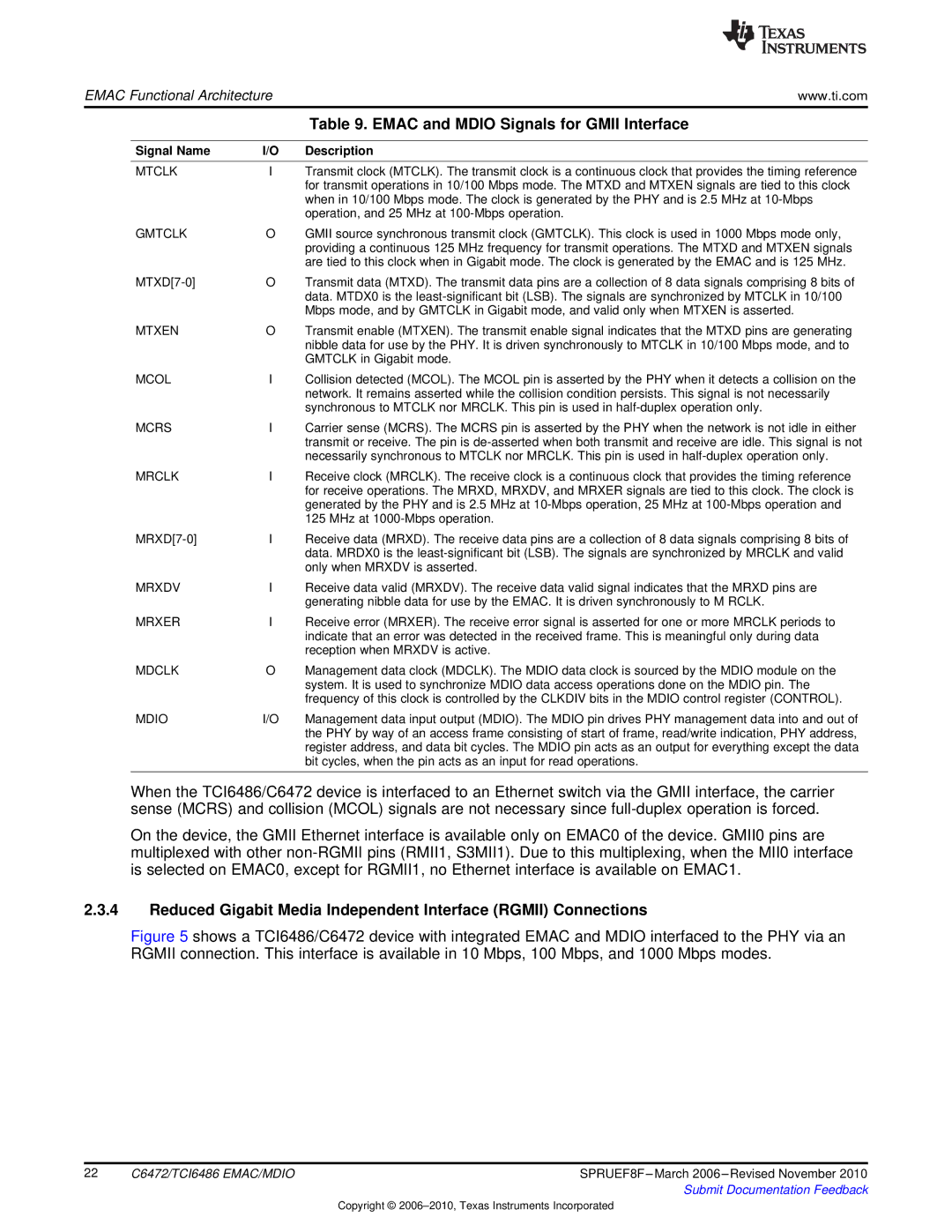
EMAC Functional Architecturewww.ti.com
|
| Table 9. EMAC and MDIO Signals for GMII Interface |
|
|
|
Signal Name | I/O | Description |
|
|
|
MTCLK | I | Transmit clock (MTCLK). The transmit clock is a continuous clock that provides the timing reference |
|
| for transmit operations in 10/100 Mbps mode. The MTXD and MTXEN signals are tied to this clock |
|
| when in 10/100 Mbps mode. The clock is generated by the PHY and is 2.5 MHz at |
|
| operation, and 25 MHz at |
GMTCLK | O | GMII source synchronous transmit clock (GMTCLK). This clock is used in 1000 Mbps mode only, |
|
| providing a continuous 125 MHz frequency for transmit operations. The MTXD and MTXEN signals |
|
| are tied to this clock when in Gigabit mode. The clock is generated by the EMAC and is 125 MHz. |
O | Transmit data (MTXD). The transmit data pins are a collection of 8 data signals comprising 8 bits of | |
|
| data. MTDX0 is the |
|
| Mbps mode, and by GMTCLK in Gigabit mode, and valid only when MTXEN is asserted. |
MTXEN | O | Transmit enable (MTXEN). The transmit enable signal indicates that the MTXD pins are generating |
|
| nibble data for use by the PHY. It is driven synchronously to MTCLK in 10/100 Mbps mode, and to |
|
| GMTCLK in Gigabit mode. |
MCOL | I | Collision detected (MCOL). The MCOL pin is asserted by the PHY when it detects a collision on the |
|
| network. It remains asserted while the collision condition persists. This signal is not necessarily |
|
| synchronous to MTCLK nor MRCLK. This pin is used in |
MCRS | I | Carrier sense (MCRS). The MCRS pin is asserted by the PHY when the network is not idle in either |
|
| transmit or receive. The pin is |
|
| necessarily synchronous to MTCLK nor MRCLK. This pin is used in |
MRCLK | I | Receive clock (MRCLK). The receive clock is a continuous clock that provides the timing reference |
|
| for receive operations. The MRXD, MRXDV, and MRXER signals are tied to this clock. The clock is |
|
| generated by the PHY and is 2.5 MHz at |
|
| 125 MHz at |
I | Receive data (MRXD). The receive data pins are a collection of 8 data signals comprising 8 bits of | |
|
| data. MRDX0 is the |
|
| only when MRXDV is asserted. |
MRXDV | I | Receive data valid (MRXDV). The receive data valid signal indicates that the MRXD pins are |
|
| generating nibble data for use by the EMAC. It is driven synchronously to M RCLK. |
MRXER | I | Receive error (MRXER). The receive error signal is asserted for one or more MRCLK periods to |
|
| indicate that an error was detected in the received frame. This is meaningful only during data |
|
| reception when MRXDV is active. |
MDCLK | O | Management data clock (MDCLK). The MDIO data clock is sourced by the MDIO module on the |
|
| system. It is used to synchronize MDIO data access operations done on the MDIO pin. The |
|
| frequency of this clock is controlled by the CLKDIV bits in the MDIO control register (CONTROL). |
MDIO | I/O | Management data input output (MDIO). The MDIO pin drives PHY management data into and out of |
|
| the PHY by way of an access frame consisting of start of frame, read/write indication, PHY address, |
|
| register address, and data bit cycles. The MDIO pin acts as an output for everything except the data |
|
| bit cycles, when the pin acts as an input for read operations. |
|
|
|
When the TCI6486/C6472 device is interfaced to an Ethernet switch via the GMII interface, the carrier sense (MCRS) and collision (MCOL) signals are not necessary since
On the device, the GMII Ethernet interface is available only on EMAC0 of the device. GMII0 pins are multiplexed with other
2.3.4Reduced Gigabit Media Independent Interface (RGMII) Connections
Figure 5 shows a TCI6486/C6472 device with integrated EMAC and MDIO interfaced to the PHY via an RGMII connection. This interface is available in 10 Mbps, 100 Mbps, and 1000 Mbps modes.
22 | C6472/TCI6486 EMAC/MDIO | SPRUEF8F |
|
| Submit Documentation Feedback |
Copyright ©
